Underbone
This articleneeds additional citations forverification.(April 2009) |
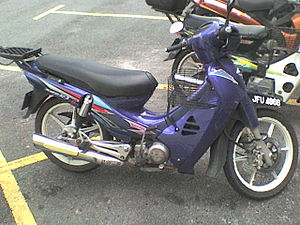

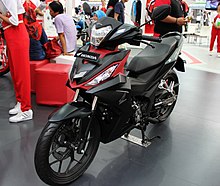
Anunderbone( cong lương xe, literal translation: curve beam car) is a type ofmotorcyclethat uses structural tube framing with an overlay of plastic or non-structural body panels and contrasts withmonocoqueorunibodydesigns wherepressed steelserves both as the vehicle's structure and bodywork. Outside Asia, the term underbone is commonly misunderstood to refer to any lightweight motorcycle that uses the construction type, known colloquially asstep-throughs,mopeds[citation needed]orscooters(seeScooter (motorcycle)).
An underbone motorcycle may share itsfuel tankposition and tube framing, along with fitted bodywork and splash guards with ascooterwhile the wheel dimensions, engine layouts, and power transmission are similar with conventional motorcycles.
Unlike conventional motorcycles, underbones are mostly popular inAsiaandGreece.InIndonesia,the fourth most populous country in the world, and the largest country in Southeast Asia, almost half the population have a motorcycle, most of which are underbones and scooters. (120 million in 2018, compared to 16 million cars[1]).
Design
[edit]The appearance and frame of an underbone are quite different from that of a standard motorcycle, but the powertrain is functionally almost identical. The underbone engine is positioned between the rider's feet but the rear wheel is driven by a regular motorcycle secondarychain drive.Styling considerations only mean that the chain-driven nature of the machine tends to be concealed under sheet-metal covers to a greater extent than that of motorcycles.
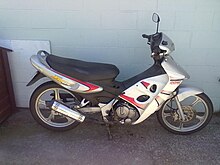
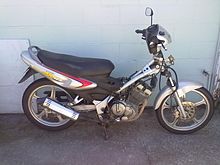

In only one significant respect does the underbone differ from the conventional motorcycle - there is no frame member or fuel tank between the seat base and the headstock. Generally, the fuel tank is located under the seat. The underbone arrangement improves the ease of mounting and dismounting and contributes to the cross-gender appeal of the layout as an around-town shopping and commuter vehicle. The engine displacement of a typical underbone motorcycle is generally between 50 cc and up to about 150 cc, though much larger ones are available. Currently, production underbone model with the largest engine displacement is theSYM VF3i,which is powered by a fuel-injected 183 ccSOHC4-valvewater-cooledengine.[2]
Historically, underbones popularizedsemi-automatic transmissionsand indicator systems. In other respects, the technical sophistication of underbones tended to lag those of larger motorcycles, but nowadays they are increasingly equipped with similar electronic ignition, fuel injection, etc.
Underbones may have spoked or alloy wheels that are spindle mounted and usually sized to fit small conventional motorcycle frames. These provide much better road-holding and braking than scooters, though it does make punctures more difficult to repair
Underbones generally features a three- to six-speedsequential gearbox,either with anautomatic clutch,usually acentrifugal clutch,or a conventionalmanual hand clutch.Depending on whether the motorcycle has a manual hand clutch or an automaticcentrifugal clutch,determines whether the motorcycle transmission is asemi-automatic(automatic clutch) or amanual transmission.It is then coupled to a sprocket and chain drive to transmit power to the rear wheel. There are some exceptions to this, such as theYamaha Lexam.Although the similar design of an underbone motorcycle, it has aCVTtransmission and therefore has no gears for the rider to select, similar to scooters.
Origins
[edit]
The underbone concept can be seen in some of the Europeanmopedsof the early 1950s, including theNSU Quicklyand theHeinkel Perle.[citation needed]The spine-framed, plastic-fairedHonda Super Cubis the most producedmotor vehicleof all time.[3][4]Production of the Super Cub began in 1958, surpassing 60 million units in April 2008, and continuing to be made in several countries around the world as of 2012[update].[5][6][7][8]
Other names and derivations
[edit]In Malaysia and Singapore this vehicle is commonly known asKapcaiorKapchai,aslangword derived from Cantonese, being a combination of the word "Cub" from the wordHonda Cuband "Tử" in Chinese. In Cantonese, "Tử" (pronounced "jai",or in pinyin"zai") means" little "(or its derivatives, e.g." small "," mini ", etc.)[citation needed].Therefore, "kapchai"literally means a" Little Cub ". With Honda being a very popular brand in Malaysia, all underbone motorbikes have come to be called" kapchai ". In Indonesia, it is called"motor bebek"[9](literally means "duck bike" ). InGreeceis known asPapiorPapaki,aslangthat also meansduck.
A variation on the underbone concept known as the "maxi-scooter"[10]or "touring scooter"[11]is popular in the West. These are much larger than the underbones known to the Asian market and vary in size from the earlyHonda Helixwith 250 cc[12]to the 850 cc Gilera GP800.[13]Many current versions are between 400 cc and 650 cc, including theHonda Silver Wingwith 582 cc,[14]the Suzuki Burgman with 400 cc[15]or 638 cc,[16]the Yamaha Majesty 400 with 395 cc,[17]and the Yamaha T-Max 500 with 499 cc.[18]
Underbones of conventional size are popular inWestern Europeand marketed alongside conventional scooters. They are sometimes referred to as scooters,[19]despite the design difference between underbones and conventional scooters.
In Southeast Asia Some manual underbone bikes are designed by cover body without side wings, full-length front shock, and sport bike look headlamp. It look more sporty and better performance than the cub underbones. For example Suzuki Raider R150, Honda Nova series, Suzuki Akira/Stinger, Yamaha MX Speed, Cagiva Stella, and many more. In Indonesia, this type of bike are called "ayago" (ayam jago means rooster)
Storage
[edit]
Underbone motorcycles often come with storage, and this may vary between markets. In Southeast Asia, there is commonly a steel basket provided as there is none under the seat, as this is the placement of the fuel tank. Some underbones have a lockable storage compartment under the seat. Some have a hook in the area between the rider's knees for a shopping bag. Another storage capacity may be provided in atop box,detachable in some cases.
Manufacturers
[edit]The market for underbone motorcycles is dominated byJapanesemanufacturers, though many of them are built in factories elsewhere, including China and Taiwan. In other cases, manufacturers have violatedcopyrightand illegally copied the models of Japanese manufacturers. TheHonda Cub,Honda Wave series,andYamaha Lagenda seriesare amongst the most copied.
MZ Motorradcurrently produces underbone models inMalaysiaby their main shareholder,Hong Leong Groupwhich is also the sole distributor ofYamahamotorcycle in Malaysia and Singapore. Mforce Bikes Holdings Sdn Bhd also producing an underbone motorcycle under Benelli Motorcycle.
The major underbone manufacturers are as follows:
- China:Haojue,Zongshen,Lifan.
- Malaysia:Modenas,Momos Motor(rebadge ofCagiva),Naza Bikers(rebadge of Zongshen), Demak and Mforce Bikes Holdings.
- Germany:MZ Motorrad
- India:TVS Motors(underbone versions are available in India, Indonesia and the Philippines)
- Indonesia:Kanzen,Binter(rebadge ofKawasaki),Viar
- Italy:Cagiva,Piaggio,Benelli
- Japan:Honda,Yamaha,Suzuki,Kawasaki
- Philippines:LuckyStar Motorcycles, MCX Motor (Phils.), Blaze Motortech, Sunriser, RUSI,
- South Korea:Daelim Motor Company
- Taiwan:Kymco,SYM Motors
- Thailand:Tiger Motor Co. Ltd
- Mexico:Italika
Culture
[edit]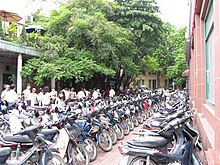
Underbones are very popular in Southeast Asia and Greece. There is a demand for aftermarket andtunerparts. Many enthusiasts modify their underbones either for a show (such as installing small sound systems,neon lightsand custom paint jobs) or for performance (likeincreasing the engine powerand fine-tuning the suspension). Riding gear may not even extend to wearing shoes and long pants for safety. Illegal underbonedrag racinghas become popular in countries such as the Philippines, Malaysia and Greece, and poses safety issues for the commuting public as well as the riders themselves, as underbones offer little protection in the event of crashes. The most popular underbone for these purposes is theHonda XRM,Suzuki Raider 150and theHonda Wave,although similar models fromKawasakiandYamahaare also frequently used.
In Singapore and Malaysia, it is not uncommon to see old bicycles customized with parts found on an underbone motorcycle, a growing trend popular with the youth.
Racing
[edit]Underbonemotorcycle racingare one of the most popular motorcycle racing class in the Southeastern Asia region, which uses a modified version of road-legal, production-based underbone motorcycle available for purchase in public, mostly manufactured byYamaha,Honda,andSuzuki.Underbone racing popularity is mostly influenced by their wide variety of racing classes, race track limitations, and fairly cheaper cost of parts and development compared to sport motorcycle classes. Underbone racing class may be further categorized into the engine cycle, engine displacement, engine layout, fuel delivery systems, allowable modifications and restrictions, time brackets (in drag racing), and the rider's skill level. These categories are then regulated by the country's motorcycle racing governing body, from which national racing series may be organized. One of the most popular categories is the 150cc four-stroke fuel-injected class and may have engine power output ranging from 24 to 32horsepowerand can reach up to 180 km/h. Most of the motorcycle competing in this class areYamaha T-150,Honda RS150R,andSuzuki Raider 150.

Notable underbone road racing series in Southeast Asia countries areMalaysian Cub Prixand Indonesian Oneprix and MotoPrix Series. The highest level for underbone road racing class is held byAsia Road Racing Championshipunder UB150 class, from which only production underbone motorcycle with a maximum of 150cc engine displacement may compete in this class, hence the name. Only Yamaha and Honda motorcycles compete in this class with teams from various Asian countries.
Underbone racing series in lower divisions in each country may also be organized to encourage new teams and riders to develop and prepare for the national racing series. In Malaysia, the underbone racing series was created in partnership with the government of Malaysia's Ministry of Youth and Culture in 2012 to encourage youth to race in a controlled track environment rather thanon the streets.[20]It was designed to have a lower cost of entry than existing underbone series, such as theMalaysian Cub Prix.
References
[edit]- ^IndoNesia:Growth of Motorized Vehicles According to Types, 1949-2018,IndoNesian Statistics Bureau.
- ^Durrani Sharom (2018-04-05)."SYM VF3i – Malaysia Negara Pertama Terima" kapcai berkapasiti paling tinggi di Dunia ", 183 cc, RM8,467".Paul Tan(in Malay).Retrieved2019-01-27.
- ^"That's 2.5 billion cc!",American Motorcyclist,Westerville, Ohio:American Motorcyclist Association,p. 24, May 2006,ISSN0277-9358,retrieved2010-10-31
- ^Edstrom, Christian (November 30, 2007),"To Save the Polar Bears, Ride a Cub",New York Times,retrieved2012-01-28
- ^Honda Press Release 21 May 2008Archived3 March 2016 at theWayback MachineCumulative Global Production of Cub Series Motorcycles Reaches 60 Million Units.
- ^Cumulative Global Production of Cub Series Motorcycles Reaches 60 Million Units (press release),Honda,May 2008, archived fromthe originalon 2016-03-03,retrieved2010-10-31
- ^Squatriglia, Chuck (23 May 2008),"Honda Sells Its 60 Millionth – Yes, Millionth – Super Cub",Wired,retrieved2010-10-31
- ^"Worldwide Production Bases",Super Cub – The Honda Worldwide Super Cub Special Site,Honda,archived fromthe originalon 2012-10-21,retrieved2012-01-30
- ^Panca, Anang (27 January 2016)."Motor Bebek dan Underbone, Apa Bedanya?".Sepeda-Motor.info.Retrieved7 December2018.
- ^"Adventure and Outdoor Sports".Popular Mechanics.Retrieved1 June2017.
- ^"2017 Touring Scooter Motorcycle Reviews, Prices and Specs".motorcycle.Retrieved1 June2017.
- ^"First Impression: Honda Helix".Retrieved1 June2017.
- ^"2008 Gilera GP 800 Review @ Top Speed".Top Speed.18 February 2008.Retrieved1 June2017.
- ^"2009 Honda Silver Wing® ABS".Motorcycle.Retrieved1 June2017.
- ^"2007 Suzuki Burgman 400 Introduction Report".Retrieved1 June2017.
- ^"2009 Suzuki Burgman 650 Executive".Motorcycle.Retrieved1 June2017.
- ^"2009 Yamaha Majesty 400".Motorcycle.Retrieved1 June2017.
- ^"2009 Yamaha TMAX".Motorcycle.Retrieved1 June2017.
- ^Fuego, Del."2009 Honda SH125i - The Scooter Review".thescooterreview.Retrieved1 June2017.
- ^"Young, fast, and safe",The Sun,Malaysia, May 6, 2014
